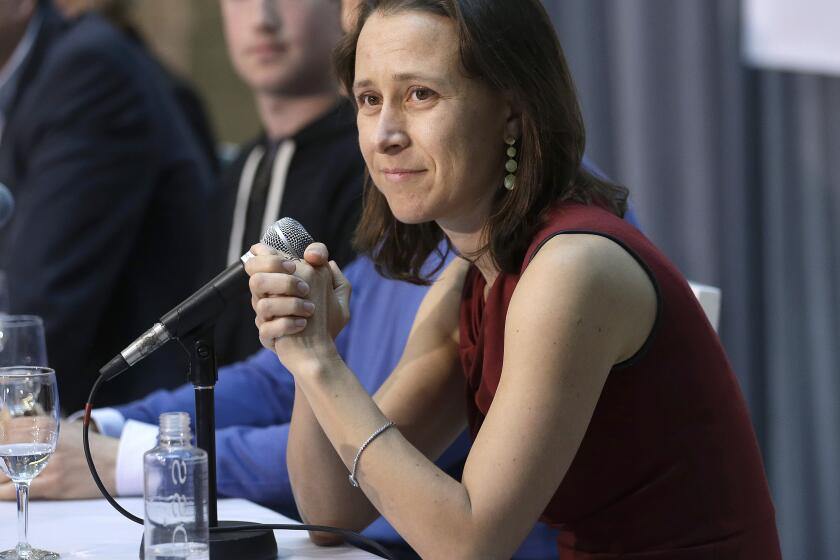Ranch for sale holds key to Lone Pine’s future
- Share via
LONE PINE, CALIF. — On a cool, crisp morning, Scott Kemp’s battered white pickup truck was the only vehicle in sight along a long, narrow lane lined with desert daisies and curious cows on the eastern flanks of jagged, gray Mt. Whitney.
The road streaked across the historic Lubken Ranch, a spread that Kemp and his three sisters inherited from their father, Sandy Kemp, after he died in 2004. Against a backdrop of rippling meadows and sagebrush rising up to the Sierra Nevada, the tall, lean cowboy shook his head and said, “It won’t be easy leaving this ranch.”
The 759-acre spread, which has been in operation for more than a century, is for sale for $6.5 million, down from the original asking price of $20 million. The property has entertained inquiries from Google and the Coachella Music and Arts Festival, according to the family’s Beverly Hills real estate broker Crosby Doe, who likes to say “it would be like owning your own national park.”
Locals are wondering how development of the largest chunk of private property to be offered for sale in Inyo County in 50 years might affect this Eastern Sierra community of 2,200 people straddling California 395.
Though Lone Pine is surrounded by open range, almost none is privately owned. The Los Angeles Department of Water and Power owns most of the acreage in Lone Pine that locals say is needed for commerce, hospitals, parking and affordable housing. As a result, even local boosters aren’t sure whether a sale of the Lubken Ranch would trigger boom times or economic benefits that will bypass Lone Pine altogether.
Founded 150 years ago, Lone Pine has been a trading post for miners and cattle ranchers, a gas stop for vacationers and a high desert backdrop for countless Hollywood movie shoots.
The next few years may be busier. The prospective sale of Lubken Ranch is one of several signs of economic change orbiting the community, which boasts 350 motel rooms and one streetlight.
Proposed developments include gold mines, solar energy facilities, luxury homes and a corporate think tank.
“It’s a terribly frustrating situation,” said Kathleen New, executive director of the Lone Pine Chamber of Commerce. “I have never seen so many regional economic opportunities on this scale before. But 100 years from now, I’m guessing we’ll look about the same as we do right now.
“We could use some upgrades,” she said, waving her arm across the gas stations, eateries, souvenir shops and empty lots edging California 395. “Forget about finding gorgonzola cheese and good olive oil, or even buying a pair of socks in Lone Pine.”
Inyo County Supervisor Richard Cervantes, a longtime Lone Pine resident, was more optimistic. “We are starved for land,” he acknowledged, “but I also believe that we’re overdue for a rebirth and recovery, and I think this time we’re going to have it.”
With gold fetching $1,200 an ounce, once-marginal mines are reopening in surrounding hills and mountains. The DWP wants to build solar energy facilities just south of town. A developer has recently won approval to build Whitney Portal Preserve; 27 lots for luxury housing along a road that hikers and campers use to reach the Mt. Whitney trailhead.
Four months ago, Lubken Ranch hit the market at a dramatically reduced price. The reason? Property values have plummeted throughout Inyo County.
In Lone Pine, the dip is so low that a commercial lot with 175 feet of frontage along California 395 next to a McDonald’s and across the street from Lone Pine High School was being offered recently for $59,000.
“We’ve had talkers, but no takers,” lamented Doe. “I just don’t understand that. For a person of means, this is one of the greatest real estate opportunities I’ve ever seen.”
The lack of serious interest in the ranch worries Katie Topping, 45, who, along with two sisters, decided to overrule their brother’s objections and put the land up for sale.
“This could spark the economic boost that Lone Pine needs,” Topping said. “It would be amazing to see the land transformed into a dude ranch with a swimming pool and cabins offering opportunities for fishing and backpacking, all of which could spin off new development in town.”
Many locals are not so sure. Lone Pine real estate broker Jenifer Castaneda believes that significant development “or even a lot of McMansions” would not be built without more commercial construction and infrastructure upgrades in town to support it.
A year ago, Castaneda was among a group of Owens Valley residents who sent a petition to Los Angeles Mayor Antonio Villaraigosa and the Los Angeles City Council urging them to force the DWP to release some of its holdings, acquired in the infamous back-room deals more than a century ago that let the agency divert the Owens River for a growing Los Angeles and dry up much of the valley.
The DWP agreed 13 years ago to relinquish 75 acres in the Owens Valley, including 12.5 acres in Lone Pine, for residential and commercial uses.
But only a few lots have changed hands because the agency tends to set minimum bids far above market value.
DWP officials said they have reappraised the 75 acres with a goal of bringing them to market in auctions, pending the approval of the Los Angeles City Council.
In the meantime, Kemp said, “it’s a big waiting game.”
“I don’t want to see anybody buy this ranch,” he said. “If I had the funds, I’d buy it. Maybe I will.”
More to Read
Inside the business of entertainment
The Wide Shot brings you news, analysis and insights on everything from streaming wars to production — and what it all means for the future.
You may occasionally receive promotional content from the Los Angeles Times.











